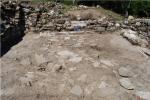Summary (English)
During the field season of 2011 the excavations continued in the funerary church of St. George and the nearby cemetery (area 2), located in the eastern slope of the lowest hill of the medieval settlement of Koman. The excavations undertaken in the north-western part of the nave revealed the floor level (US 2023), which in a later phase of use was paved with limestone slabs, set in a thin layer of mortar. In the middle part of the northern wall (from the inner side) of the nave (USM 2), perpendicularly to it, a wall line of 0, 6 m wide (USM 5), which extends 2m toward the north, was uncovered. The wall was either part of a dividing wall between the sacred area and the nave, or it was the stylobate of the iconostas. The discovery of several painted plaster fragments supports the idea that the inner part of the church was painted in frescos. However, at the current research and conservation phase, the density and character of decoration remains unknown. The territory in front of the nave was also excavated and cleaned from the fallen walls. At an occupation level, in front of the church, a group of Byzantine silver coins of the middle of the 9th Century AD was founded.
The excavations undertaken around the territory of the church revealed 7 graves, found below the debris layer of the destruction of the church: two of them (322 and 324) were identified near the monument’s entrance, one (323) in its northwestern corner; two (328 and 329) near the north-eastern curve of the apse, and two other (318-319), approximately 15 m to the south-east of the head of the church. At the end of the season, only 4 of the graves were excavated (322, 323, 318 and 319), which due to their visibility and location, after the site was cleaned, were at huge risk of illicit excavation. Grave 322 was installed against the western wall, amidst the doorway and the northwestern corner of the church. It was constructed of stone blocks and stone slabs, including half of a mill stone.. It contained several skeletons of recently-buried individuals, and an in situ preserved skeletons. A star pendant of a bronze earring was founded in the graves, dated between the 8-9th centuries AD. The other two graves (318 and 319) contained several skeleton remains, damaged by the vegetation. However, the skeletons of grave 319 seem to belong to 3 adult individuals and of a 2 or 3 years old infant. The associated grave goods discovered in these two graves consisted of a bronze earring with a trapeze-shape pendant, a bronze belt buckle and several glass beads, which date to the 7-8th century AD.
Director
- Etleva Nallbani - CNRS/UMR 8167
Team
Research Body
- Instituti Arkeologjik Tiranë (Albanian Institute of Archaeology)
- École Française de Rome
Funding Body
- Ministère de l'Europe et des Affaires étrangères






![Download [PDF]](/excavation/skins/fasti/images/results/download_sml.png)